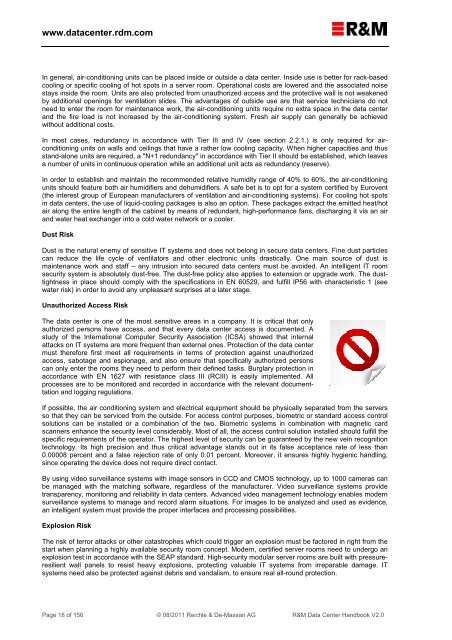R&M Data Center Handbook
R&M Data Center Handbook
R&M Data Center Handbook
You also want an ePaper? Increase the reach of your titles
YUMPU automatically turns print PDFs into web optimized ePapers that Google loves.
www.datacenter.rdm.com<br />
In general, air-conditioning units can be placed inside or outside a data center. Inside use is better for rack-based<br />
cooling or specific cooling of hot spots in a server room. Operational costs are lowered and the associated noise<br />
stays inside the room. Units are also protected from unauthorized access and the protective wall is not weakened<br />
by additional openings for ventilation slides. The advantages of outside use are that service technicians do not<br />
need to enter the room for maintenance work, the air-conditioning units require no extra space in the data center<br />
and the fire load is not increased by the air-conditioning system. Fresh air supply can generally be achieved<br />
without additional costs.<br />
In most cases, redundancy in accordance with Tier III and IV (see section 2.2.1.) is only required for airconditioning<br />
units on walls and ceilings that have a rather low cooling capacity. When higher capacities and thus<br />
stand-alone units are required, a "N+1 redundancy" in accordance with Tier II should be established, which leaves<br />
a number of units in continuous operation while an additional unit acts as redundancy (reserve).<br />
In order to establish and maintain the recommended relative humidity range of 40% to 60%, the air-conditioning<br />
units should feature both air humidifiers and dehumidifiers. A safe bet is to opt for a system certified by Eurovent<br />
(the interest group of European manufacturers of ventilation and air-conditioning systems). For cooling hot spots<br />
in data centers, the use of liquid-cooling packages is also an option. These packages extract the emitted heat/hot<br />
air along the entire length of the cabinet by means of redundant, high-performance fans, discharging it via an air<br />
and water heat exchanger into a cold water network or a cooler.<br />
Dust Risk<br />
Dust is the natural enemy of sensitive IT systems and does not belong in secure data centers. Fine dust particles<br />
can reduce the life cycle of ventilators and other electronic units drastically. One main source of dust is<br />
maintenance work and staff – any intrusion into secured data centers must be avoided. An intelligent IT room<br />
security system is absolutely dust-free. The dust-free policy also applies to extension or upgrade work. The dusttightness<br />
in place should comply with the specifications in EN 60529, and fulfill IP56 with characteristic 1 (see<br />
water risk) in order to avoid any unpleasant surprises at a later stage.<br />
Unauthorized Access Risk<br />
The data center is one of the most sensitive areas in a company. It is critical that only<br />
authorized persons have access, and that every data center access is documented. A<br />
study of the International Computer Security Association (ICSA) showed that internal<br />
attacks on IT systems are more frequent than external ones. Protection of the data center<br />
must therefore first meet all requirements in terms of protection against unauthorized<br />
access, sabotage and espionage, and also ensure that specifically authorized persons<br />
can only enter the rooms they need to perform their defined tasks. Burglary protection in<br />
accordance with EN 1627 with resistance class III (RCIII) is easily implemented. All<br />
processes are to be monitored and recorded in accordance with the relevant documenttation<br />
and logging regulations.<br />
If possible, the air conditioning system and electrical equipment should be physically separated from the servers<br />
so that they can be serviced from the outside. For access control purposes, biometric or standard access control<br />
solutions can be installed or a combination of the two. Biometric systems in combination with magnetic card<br />
scanners enhance the security level considerably. Most of all, the access control solution installed should fulfill the<br />
specific requirements of the operator. The highest level of security can be guaranteed by the new vein recognition<br />
technology. Its high precision and thus critical advantage stands out in its false acceptance rate of less than<br />
0.00008 percent and a false rejection rate of only 0.01 percent. Moreover, it ensures highly hygienic handling,<br />
since operating the device does not require direct contact.<br />
By using video surveillance systems with image sensors in CCD and CMOS technology, up to 1000 cameras can<br />
be managed with the matching software, regardless of the manufacturer. Video surveillance systems provide<br />
transparency, monitoring and reliability in data centers. Advanced video management technology enables modern<br />
surveillance systems to manage and record alarm situations. For images to be analyzed and used as evidence,<br />
an intelligent system must provide the proper interfaces and processing possibilities.<br />
Explosion Risk<br />
The risk of terror attacks or other catastrophes which could trigger an explosion must be factored in right from the<br />
start when planning a highly available security room concept. Modern, certified server rooms need to undergo an<br />
explosion test in accordance with the SEAP standard. High-security modular server rooms are built with pressureresilient<br />
wall panels to resist heavy explosions, protecting valuable IT systems from irreparable damage. IT<br />
systems need also be protected against debris and vandalism, to ensure real all-round protection.<br />
Page 18 of 156 © 08/2011 Reichle & De-Massari AG R&M <strong>Data</strong> <strong>Center</strong> <strong>Handbook</strong> V2.0


